- Home
- Jeffery Deaver
The Final Twist
The Final Twist Read online
ALSO BY JEFFERY DEAVER
NOVELS
The Colter Shaw Series
The Goodbye Man
The Never Game
The Lincoln Rhyme Series
The Cutting Edge
The Burial Hour
The Steel Kiss
The Skin Collector
The Kill Room
The Burning Wire
The Broken Window
The Cold Moon
The Twelfth Card
The Vanished Man
The Stone Monkey
The Empty Chair
The Coffin Dancer
The Bone Collector
The Kathryn Dance Series
Solitude Creek
XO
Roadside Crosses
The Sleeping Doll
The Rune Series
Hard News
Death of a Blue Movie Star
Manhattan Is My Beat
The John Pellam Series
Hell’s Kitchen
Bloody River Blues
Shallow Graves
Stand-Alones
The October List
No Rest for the Dead (Contributor)
Carte Blanche (A James Bond Novel)
Watchlist (Contributor)
Edge
The Bodies Left Behind
Garden of Beasts
The Blue Nowhere
Speaking in Tongues
The Devil’s Teardrop
A Maiden’s Grave
Praying for Sleep
The Lesson of Her Death
Mistress of Justice
Short Fiction
COLLECTIONS
Trouble in Mind
More Twisted
Twisted
ANTHOLOGIES
Nothing Good Happens After Midnight (Editor and Contributor)
A Hot and Sultry Night for Crime (Editor and Contributor)
Ice Cold (Editor and Contributor)
Books to Die For (Contributor)
The Best American Mystery Stories 2009 (Editor)
STORIES
Forgotten
Turning Point
Verona
The Debriefing
The Second Hostage
Ninth and Nowhere
Captivated
The Victims’ Club
Surprise Ending
Double Cross
The Deliveryman
A Textbook Case
G. P. Putnam’s Sons
Publishers Since 1838
An imprint of Penguin Random House LLC
Penguinrandomhouse.com
Copyright © 2021 by Gunner Publications, LLC
Excerpt from The Midnight Lock copyright © 2021 by Gunner Publications, LLC
Penguin supports copyright. Copyright fuels creativity, encourages diverse voices, promotes free speech, and creates a vibrant culture. Thank you for buying an authorized edition of this book and for complying with copyright laws by not reproducing, scanning, or distributing any part of it in any form without permission. You are supporting writers and allowing Penguin to continue to publish books for every reader.
Hardcover ISBN: 9780525539131
Ebook ISBN: 9780525539155
Book design by Laura K. Corless, adapted for ebook by Maggie Hunt
This is a work of fiction. Names, characters, places, and incidents either are the product of the author’s imagination or are used fictitiously, and any resemblance to actual persons, living or dead, businesses, companies, events, or locales is entirely coincidental.
Cover design: Tal Goretsky
Cover image: Jonathan Arias / iStock / Getty Images Plus
pid_prh_5.7.0_c0_r0
To the Sunday Afternoon Crew: Joan, Cleve, Kay, Ralph, Gail
Contents
Cover
Also by Jeffery Deaver
Title Page
Copyright
Dedication
Epigraph
The Steelworks
Part One: June 24 | The Mission
Chapter 1
Chapter 2
Chapter 3
Chapter 4
Chapter 5
Chapter 6
Chapter 7
Chapter 8
Chapter 9
Chapter 10
Chapter 11
Chapter 12
Chapter 13
Chapter 14
Chapter 15
Chapter 16
Chapter 17
Chapter 18
Chapter 19
Chapter 20
Chapter 21
Chapter 22
Chapter 23
Chapter 24
The Steelworks
Part Two: June 25 | The Great Earthquake
Chapter 25
Chapter 26
Chapter 27
Chapter 28
Chapter 29
Chapter 30
Chapter 31
Chapter 32
Chapter 33
Chapter 34
Chapter 35
Chapter 36
Chapter 37
Chapter 38
Chapter 39
Chapter 40
Chapter 41
Chapter 42
Chapter 43
Chapter 44
Chapter 45
Chapter 46
Chapter 47
Chapter 48
Chapter 49
Chapter 50
Chapter 51
Chapter 52
Chapter 53
Part Three: June 26 | The Man Who Would Be King
Chapter 54
Chapter 55
Chapter 56
Chapter 57
Chapter 58
Chapter 59
Chapter 60
Chapter 61
Chapter 62
Chapter 63
Chapter 64
Chapter 65
Chapter 66
Chapter 67
Chapter 68
Chapter 69
Chapter 70
Chapter 71
Chapter 72
Chapter 73
Chapter 74
Chapter 75
Part Four: June 27 | Flame
Chapter 76
Chapter 77
Chapter 78
Chapter 79
Chapter 80
Chapter 81
Part Five: July 3 | Ash
Chapter 82
Acknowledgments
Excerpt from The Midnight Lock
About the Author
For the powerful, crimes are those that others commit.
—Noam Chomsky
THE STEELWORKS
Colter Shaw draws his gun. He starts silently down the stairs, descending into the old building’s massive, pungent basement, redolent of mold and heating oil.
Basement, he reflects. Recalling the last time he was in one. And what happened to him there.
Above him, music pounds, feet dance. The bass is a runner’s heartbeat. But up there and down here are separate universes.
At the foot of the stairs he studies where he is. Orientation . . . Always, orientation. The basement is half built out. To the right of the stairs is a large
empty space. To the left are rooms off a long corridor—fifty feet or so in length.
Scanning the empty space to the right, he sees no threat nor anything that would help him. He turns left and navigates toward the corridor past the boilers and stores of supplies: large packs of toilet paper, cans of Hormel chili, plastic water bottles, paper towels, Dixie paper plates, plastic utensils. A brick of nine-millimeter ammunition.
Shaw moves slowly into the corridor. The first room on the right, the door open, is illuminated by cold overhead light and warmer flickering light. Remaining in shadows, he peers in quickly. An office. File cabinets, computers, a printer.
Two bulky men sit at a table, watching a baseball game on a monitor. One leans back and takes the last beer from the six-pack sitting on a third chair. Shaw knows they’re armed because he knows their profession, and such men are always armed.
Shaw is not invisible but the basement is dark, no overheads, and he’s in a black jacket, jeans and—since he’s been motorcycling—boots. They’re not as quiet as the Eccos he usually wears but the beat bleeding from the dance floor overhead dampens his footsteps. He supposes it would even drown out gunshots.
The men watch the game and talk and joke. There are five empty bottles. This might be helpful: the alcohol consumed. The reaction-time issue. The accuracy issue.
If it comes to that.
He thinks: Disarm them now?
No. It could go bad. Seventy-five percent chance of success, at best.
He hears his father’s voice: Never be blunt when subtle will do.
Besides, he isn’t sure what he’ll find here. If nothing, he’ll slip out the way he came, with them none the wiser.
He eases past the doorway, unseen, then pauses to give his eyes, momentarily dulled by the office lights, a chance to acclimate to the darkness.
Then he moves on, checking each room. Most of the doors are open; most of the rooms are dark.
The music, the pounding of the dancing feet are a two-edged sword. No one can hear him approach, but he’s just as deaf. Someone could be in an empty room, having spotted him, waiting with a weapon.
Thirty feet, forty.
Empty room, empty room. He’s approaching the end, where a second hallway jogs right. There’ll be other rooms to search. How many more?
The last room. This door is closed. Locked.
He withdraws his locking-blade knife and uses the edge near the tip to ease the deadbolt back into the tumbler. He pulls on the door to keep the bolt from snapping back into place as he gets a new grip with the blade. After repeating a dozen times, the door is free. Knife away, gun drawn and raised, finger off the trigger.
Inside.
The woman is Black, in her early twenties, hair in a complicated braid. She wears jeans and a dusty gray sweatshirt. She sees the gun and inhales to scream. He holds up a hand and instantly holsters the weapon. “It’s okay. You’re going to be okay. I’m getting you out of here. What’s your name?”
She doesn’t speak for a moment. Then: “Nita.”
“I’m Colter. You’ll be all right.”
The place is filthy. Uneaten chili sits in a flat pool on a paper plate. A bottle of water is half drunk. There’s a bucket for a toilet. She’s not bound but she is restrained: a bicycle cable is looped around a water or sewage pipe and her ankle is zip-tied to the cable. Shaw shuts the light off. There’s enough illumination to see by.
Shaw looks back into the corridor. The flicker from the screen continues as the ball game continues. What inning is it? Would be important to know.
“Are you hurt?”
She shakes her head.
He takes his knife out and opens it with a click. He saws through the plastic tie and helps her to her feet. She’s unsteady.
“Can you walk?”
A nod. She’s shivering and crying. “I want to go home.”
Shaw recalls thinking of the game Rock, Paper, Scissors just ten minutes ago. He wishes he’d played harder, much harder.
They step into the corridor. And just then, Shaw thinks:
The third chair.
Oh, hell.
The six-pack didn’t need its own seat. Someone else was in the office watching the game.
And at that moment the third man comes down the stairs with another pack of Budweiser. Just as he sets foot on the concrete floor he glances up the corridor and sees Shaw and Nita. The six-pack drops to the ground. At least one bottle shatters. He calls, “Hey!” And reaches for his hip.
In the baseball room, the flickering stops.
PART ONE
JUNE 24
THE MISSION
Time until the family dies: fifty-two hours.
1
The safe house.
At last.
Colter Shaw’s journey to this cornflower-blue Victorian on scruffy Alvarez Street in the Mission District of San Francisco had taken him weeks. From Silicon Valley to the Sierra Nevadas in eastern California to Washington State. Or, as he sat on his Yamaha motorcycle, looking up at the structure, he reflected: in a way, it had taken him most of his life.
As often is the case when one arrives at a long-anticipated destination, the structure seemed modest, ordinary, unimposing. Though if it contained what Shaw hoped, it would prove to be just the opposite: a mine of information that could save hundreds, perhaps thousands, of lives.
But as the son of a survivalist, Shaw had a preliminary question: Just how safe a safe house was it?
From this angle, it appeared deserted, dark. He dropped the transmission in gear and drove to the alley that ran behind the house, where he paused again, in front of an overgrown garden, encircled by a gothic wrought-iron fence. From here, still no lights, no signs of habitation, no motion. He gunned the engine and returned to the front. He skidded to a stop and low-gear muscled the bike onto the sidewalk.
He snagged his heavy backpack, chained up the bike and helmet, then pushed through the three-foot-deep planting bed that bordered the front. Behind a boxwood he found the circuit breakers for the main line. If there were an unlikely bomb inside it would probably be hardwired; whether it was phones or computers or improvised explosive devices, it was always tricky to depend on batteries.
Using the keys he’d been bequeathed, he unlocked and pushed open the door, hand near his weapon. He was greeted only with white noise and the scent of lavender air freshener.
Before he searched for the documents he hoped his father had left, he needed to clear the place.
No evidence of threat isn’t synonymous with no threat.
He scanned the ground floor. Beyond the living room was a parlor, from which a stairway led upstairs. Past that room was a dining room and, in the back, a kitchen, whose door, reinforced and windowless, led onto the alleyway. Another door in the kitchen led to the cellar, an unusual feature in much of California. The few pieces of furniture were functional and mismatched. The walls were the color of old bone, curtains sun-bleached to inadvertent tie-dye patterns.
He took his time examining every room on this floor and on the second and third stories. No sign of current residents, but he did find bed linens neatly folded on a mattress on the second floor.
Last, the basement.
He clicked on his tactical halogen flashlight, with its piercing beam, and descended to see that the room was largely empty. A few old cans of paint, a broken table. At the far end was a coal bin, in which a small pile of glistening black lumps sat. Shaw smiled to himself.
Ever the survivalist, weren’t you, Ashton?
As he stared into the murk, he noted three wires dangling from the rafters. One, near the stairs, ended in a fixture and a small bulb. The wires in the middle and far end had been cut and the ends were wrapped with electrician’s tape.
Shaw knew why the two had been operated on: to keep someone from getting a good view of th
e end of the cellar.
Shining the beam over the back wall, he stepped close.
Got it, Ash.
As with the rest of the basement, this wall was constructed of four-by-eight plywood sheets nailed to studs, floor to ceiling, painted flat black. But an examination of the seams of one panel revealed a difference. It was a hidden door, opening onto a secure room. He took the locking-blade knife from his pocket and flicked it open. After scanning the surface a moment longer, he located a slit near the bottom. He pushed the blade inside and heard a click. The door sprung outward an inch. Replacing the knife and drawing his gun, he crouched, shining the beam inside, holding the flashlight high and to the left to draw fire, if an enemy were present and armed.
He reached inside and felt for tripwires. None.
He slowly drew the door toward him with his foot.
It had moved no more than eighteen inches when the bomb exploded with a searing flash and a stunning roar and a piece of shrapnel took him in the chest.
2
The risk in detonations is usually not death.
Most victims of an IED are blinded, deafened and/or mutilated. Modern bomb materials move at more than thirty thousand feet per second; the shock wave could travel from sea level to the top of Mount Everest in the time it takes to clear your throat.
Shaw lay on the floor, unable to see, unable to hear, coughing, in pain. He touched the spot where the shrapnel had slammed into him. Sore. But no broken-skin wound. For some reason the skin hadn’t broken. He did a fast inventory of the rest of his body. His arms, hands and legs still functioned.
Now: find his weapon. A bomb is often a prelude to an attack.
He could see nothing but, on his knees, he patted the damp concrete in a circular pattern until he located the gun.
Squinting, but still seeing nothing. You can’t will your vision to work.
No time for panic, no time for thinking of the consequences to his lifestyle if he’d been permanently blinded or deafened. Rock climbing, motorbiking, traveling the country—all endangered, but not something to worry about right now.

 A Maiden's Grave
A Maiden's Grave Trouble in Mind: The Collected Stories - 3
Trouble in Mind: The Collected Stories - 3 The October List
The October List The Deliveryman
The Deliveryman Garden of Beasts
Garden of Beasts Triple Threat
Triple Threat The Broken Window
The Broken Window The Steel Kiss
The Steel Kiss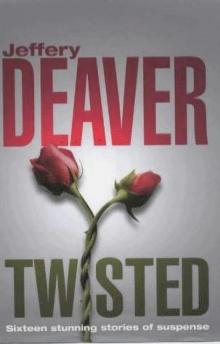 Twisted: The Collected Stories - 1
Twisted: The Collected Stories - 1 Solitude Creek
Solitude Creek Edge
Edge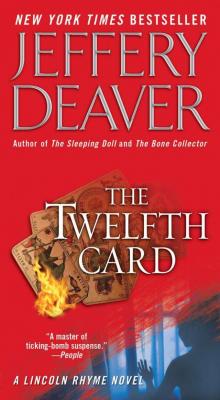 The Twelfth Card
The Twelfth Card The Bone Collector
The Bone Collector The Stone Monkey
The Stone Monkey The Sleeping Doll
The Sleeping Doll The Vanished Man
The Vanished Man The Kill Room
The Kill Room The Burial Hour
The Burial Hour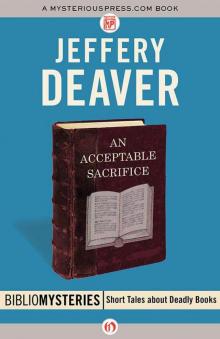 An Acceptable Sacrifice
An Acceptable Sacrifice The Coffin Dancer
The Coffin Dancer The Lesson of Her Death
The Lesson of Her Death The Empty Chair
The Empty Chair The Burning Wire
The Burning Wire Watchlist
Watchlist Captivated
Captivated The Cold Moon
The Cold Moon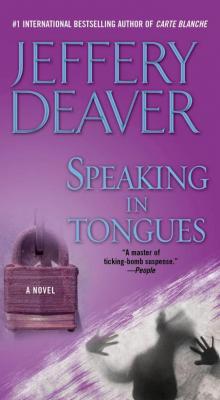 Speaking in Tongues
Speaking in Tongues Buried (Hush collection)
Buried (Hush collection) A Textbook Case
A Textbook Case The Victims' Club
The Victims' Club Nothing Good Happens After Midnight: A Suspense Magazine Anthology
Nothing Good Happens After Midnight: A Suspense Magazine Anthology The Bodies Left Behind
The Bodies Left Behind Turning Point
Turning Point Hard News
Hard News The Blue Nowhere
The Blue Nowhere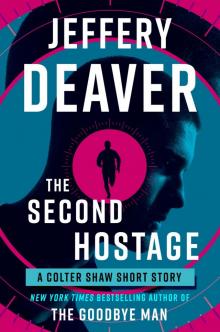 The Second Hostage
The Second Hostage The Never Game
The Never Game The Devil's Teardrop
The Devil's Teardrop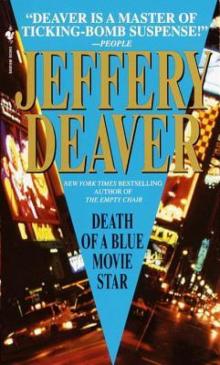 Death of a Blue Movie Star
Death of a Blue Movie Star The Skin Collector
The Skin Collector The Final Twist
The Final Twist Surprise Ending
Surprise Ending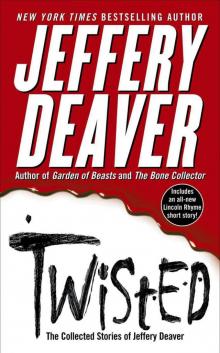 Twisted: The Collected Stories
Twisted: The Collected Stories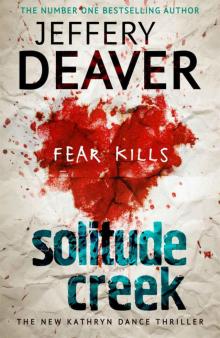 Solitude Creek: Kathryn Dance Book 4
Solitude Creek: Kathryn Dance Book 4 Twisted: The Collected Short Stories of Jeffery Deaver
Twisted: The Collected Short Stories of Jeffery Deaver Rhymes With Prey
Rhymes With Prey Shallow Graves
Shallow Graves Bloody River Blues
Bloody River Blues Trouble in Mind: The Collected Stories, Volume 3
Trouble in Mind: The Collected Stories, Volume 3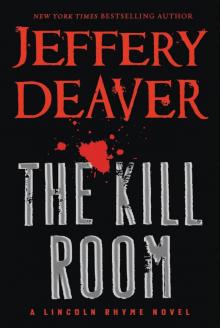 Lincoln Rhyme 10 - The Kill Room
Lincoln Rhyme 10 - The Kill Room The Cutting Edge
The Cutting Edge Where the Evidence Lies
Where the Evidence Lies Hell's Kitchen
Hell's Kitchen Twisted
Twisted The Goodbye Man
The Goodbye Man The burning wire lr-9
The burning wire lr-9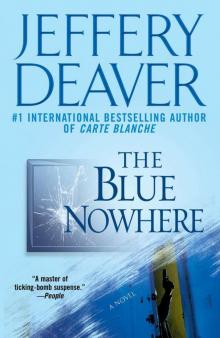 The Blue Nowhere: A Novel
The Blue Nowhere: A Novel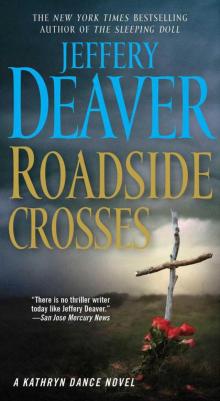 Roadside Crosses: A Kathryn Dance Novel
Roadside Crosses: A Kathryn Dance Novel The Debriefing
The Debriefing More Twisted: Collected Stories, Vol. II
More Twisted: Collected Stories, Vol. II The Kill Room lr-10
The Kill Room lr-10 A Dish Served Cold
A Dish Served Cold Bloody River Blues: A Location Scout Mystery
Bloody River Blues: A Location Scout Mystery The Bodies Left Behind: A Novel
The Bodies Left Behind: A Novel Where the Evidence Lies (A Mulholland / Strand Magazine Short)
Where the Evidence Lies (A Mulholland / Strand Magazine Short) A Textbook Case (lincoln rhyme)
A Textbook Case (lincoln rhyme) Copycat
Copycat The Chopin Manuscript: A Serial Thriller
The Chopin Manuscript: A Serial Thriller Carte Blanche
Carte Blanche The Sequel
The Sequel